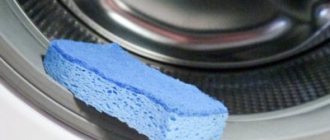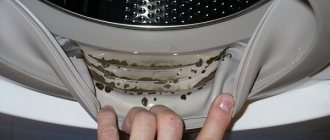Any equipment, including household appliances, requires care! Without timely cleaning, the service life of the washing machine (even if it seems to you that it does a good job without your help) is reduced. Let's figure out how to quickly and effectively clean a washing machine with your own hands.
Important! Before taking any action, carefully read the operating manual of the washing machine and familiarize yourself with the manufacturer's recommendations and warranty statements.
How to clean an iron at home: 6 ways
How to clean a cuff in the washing machine
The rubber cuff (or more simply put, rubber) is a real breeding ground for germs, fungus and mold, so caring for it affects the service life of the drum itself. It is best to wipe moisture from the cuff after each wash, which will make it easier to care for in the future.
To wash the cuff, apply a solution of detergent to it and scrub it thoroughly with a sponge, making sure to avoid hard-to-reach areas, and then wipe dry. In case of really serious contamination, the rubber seal can be removed, but we strongly recommend that you only do this if you are confident that you can do it correctly. Usually the cuff is attached from the outside with a wire clamp, which can be pryed off with a screwdriver by moving it in a circle. The inner part of the cuff is usually attached to the tank using a spring; when dismantling, it can be removed along with it. You can wash the gum in a basin in water with the addition of bleach. It is important to keep in mind that removing the cuff is still somewhat easier than putting it back in place, so do not experiment if you are not confident in your abilities.
How to clean a frying pan outside and inside: 6 tips and life hacks for different pans
Recommendations for cleaning fiberglass particles from clothing
It is necessary to work only in special clothing. If the material gets on ordinary things, you need to quickly remove it from them. Below is a method on how to remove glass wool from clothing. Necessary:
Remove fiberglass residue from clothing by rinsing it under a strong stream of cold water.
Do not immediately wet laundry that has been exposed to glass fibers. They penetrate deeper into wet fabric, after which it will be difficult to remove them from clothing. It is recommended to blow off fragments of material from things with a vacuum cleaner running at full power. Additionally, you can go over things with an antistatic roller.
A roller can be used to remove fiberglass from items.
Do not machine wash clothes containing fiberglass particles. Suitable for hand washing only. It is recommended to repeat this up to four times. If washing at home does not solve the problem, then you need to take the items to the dry cleaner. It is important to inform employees in advance that there are fiberglass fragments left in the clothing.
You should not work with the material in woolen items. In the future, it will be difficult to clean them from glass wool. You should not attempt to remove mineral wool fragments from clothing if it is heavily contaminated with them. Even repeated washing will not remove the glass fibers from it. It is recommended to throw away such clothes and buy new ones.
How to clean a washing machine drum
Formally, it is believed that high-quality cleaning of the drum should be carried out at least once every couple of months. The problem is that at high temperatures scale forms (especially with a high level of water hardness), and at low temperatures bacteria and fungi thrive. Therefore, no matter what washing modes you choose, the drum will still require care and attention from you.
Removing hairs from the hatch cuff
Debris often gets stuck between the folds of the rubber seal, and pet hair is no exception. Folding back the bottom edge of the cuff, you can see the hair “balls” that have accumulated there. It is convenient to clean the gasket with a regular damp cloth, which fits into a narrow space without any problems.
Sometimes intensive treatment of the cuff can be performed. Apply a little white to the sponge and wipe the surface of the rim with it. Next, you need to close the hatch door and wait half an hour for the best effect of the product. Then the seal should be washed with a cloth soaked in clean water and wiped dry.
Do not clean the drum cuff with household chemicals containing caustic acids.
Aggressive components damage the rubber seal. In addition, such chemicals are dangerous to humans and can cause hand skin irritation and allergies.
How to clean the powder and conditioner tray in a washing machine
The detergent drawer is a particularly vulnerable area. If you ignore litter box maintenance, at some point you will find plaque, rust and mold inside it. Accumulated dirt and detergent residues impede the movement of water through the compartment, so the quality of the wash will suffer, not to mention the fact that mold can be harmful to health.
Most containers in the area of the air conditioner compartment have a special tab that you need to press on and at the same time pull the tray towards you. However, for some brands everything is much more complicated (for example, if the detergent compartment does not pull out like a drawer, but like a fan). Under no circumstances try to remove the tray using brute force - there is a risk of simply breaking it. If you do not know how to remove the dispenser and the instruction manual does not help or does not contain such information, it is better to limit cleaning to the inside of the container without attempting to remove it.
You can get rid of dirt using an old toothbrush and a mild cleanser. If you managed to remove the tray, you can first soak it in a soapy solution in a basin and then clean it with a brush. Folk remedies will help you cope with stubborn mold stains: vinegar or vinegar with soda - moisten a cotton pad and apply the mixture to the stains. If you pulled out the tray, take a look inside before putting it back. Mold and plaque may also be found there, which again a toothbrush will help you reach.
When finished cleaning, wipe all parts with a dry cloth.
Glass wool gets on your skin: what to do?
If you are unlucky enough to get glassy skin on your skin, you will immediately begin to experience terrible itching. Action must be taken as soon as possible. First of all, close your eyes, hold your breath and shake off your head, as there may be a lot of glass particles left in your hair.
Now you need to take a shower under strong pressure. The water should be cool, preferably no higher than body temperature. This is due to the fact that when taking hot water treatments, the skin pores become wider and this is fraught with particles getting inside. For the same reason, do not rub the skin with your hands or a washcloth, so as not to create microdamages on it.
After taking a shower, you need to dry off, but without wiping yourself, and then repeat the water procedure, but using hygiene products: soap or shower gel. Sometimes, even after complete cleansing of the skin from glass wool, the itching continues to annoy for some time. There are several ways to get rid of an unpleasant symptom:
- Wet a towel with cold water or wrap ice in it and apply it to the inflamed area. Low temperature relieves itching well;
- if cooling does not help, you need to anoint the damaged area. For these purposes, aloe, fermented milk products or calendula tincture are suitable, which not only perfectly relieves irritation, but also disinfects the skin.
A similar situation may arise after gluing walls with fiberglass wallpaper, since the same materials are used for their manufacture as for the manufacture of glass wool. In any case, try to protect vulnerable areas of the body as much as possible when working.
Interesting:
- How to wash socks correctly
- Washing white socks in the washing machine
- What fabrics shrink when washed?
- How to wash things without pilling?
- How to wash a coat in an automatic machine?
- How to wash a ski suit
Reader comments
- Share your opinion - leave a comment
How to clean the washing machine drain filter
This filter is located on the front side of the washing machine in its lower part (left or right). Typically, the filter is hidden behind a removable panel or small hatch. It is really necessary to clean it, since fabric fibers, large debris and dirt can become trapped in it. Over time, the water will not completely drain from the machine, and the clothes will remain wetter after spinning.
To clean the filter, turn off the power and turn off the water supply. Before removing the filter, prepare a basin and a rag - there is always water in the drain system. Remove the filter and clean any large debris, then wash the filter with a coarse sponge under running warm water. Be sure to check the hole in the machine and also clean it of any remaining debris, dirt and plaque. Then return the filter to its place, making sure that it fits in without distortion, and tighten the filter plug. Don’t forget to plug in the machine immediately after installation and check for leaks using a test rinse. If not a drop has leaked out from under the filter cover, you can replace the closing panel.
How to clean a microwave: 3 super ways for different stains + life hack for cleaning the door
Best answers
Samoilenko Vadim:
spill with summer water. but for a long time
siddis:
How much does this robe cost, is it really impossible to buy it anymore, is it a fancy dress embroidered with gold? NO. This is a robe. Buy another one. Write this one off as low value.
Lelka:
It would not be possible to wash it off, but first to remove it from the clothes with a sticky roller. It is unlikely to come off when washed.
you can’t wash it, since glass wool is wool with rubble glass, but you can wash it, but only if there are other clothes under the glass wool clothes
LIOKO:
I doubt it's possible
Andrey Volkov:
Grandfather Au:
no way - just collect it with a round sticky “brush” I don’t know what it’s called then a vacuum cleaner
Igor Iskandarov:
Wash two or three times.
Experts prohibit
You need to clean the machine correctly. There are several prohibitions that experts constantly warn housewives about. What not to do when caring for your washing machine:
- wash equipment without unplugging the power cord from the outlet;
- use a spray bottle or shower head when cleaning equipment;
- use cleaning products not intended for vending machines;
- allow the electrical components of the washing machine to get wet, in particular the motor;
- remove scale from the heating element with sandpaper. Although some users still resort to this method;
- use aggressive compounds, for example, solvents, to treat machine parts.
If you clean a washing machine connected to the network, there is a high risk of getting an electric shock. Using aggressive means to process machine elements can cause serious damage to the equipment. To ensure that washing machine care is effective and safe, it is important to follow the recommendations of specialists.
What are the stages in a comprehensive cleaning?
Unfortunately, there is no way to clean the entire washing machine at once with the press of a button. This needs to be done in stages. Usually the main problems arise with the drum and heating element (tubular electric heater). Scale may form on it. In addition, during comprehensive cleaning you need to wash the filters, drainage hose, cuff and powder compartment. We'll tell you everything in order.
What is the potential danger of each variety?
Mineral wool refers to fiber made from materials such as glass, stone, and slag. Depending on the raw material, it is glass wool, slag wool or (basalt) wool, respectively.
80% of glass wool production is represented by cullet; limestone and soda, ethiboron and sand are also present. The main disadvantage of the resulting material is its fragility and fragility. During work, the smallest particles of glass wool can easily penetrate not only under clothing, but also into the respiratory tract. Therefore, according to safety precautions, you should carry out work in special clothing, covering your face with a respirator and safety glasses. Clothing can no longer be cleaned or washed.
The basis of slag wool is blast furnace slag, which tends to form an aggressive environment for metals due to residual acidity. Slag wool fibers are no less fragile than glass wool.
Stone wool is made from rocks of the gabbro-basalt group. Its fibers can withstand temperatures up to 1000 degrees, although the binder is only 250. They are not at all sharp, as in the previous two cases, which is why stone wool is most often used for insulating walls and roofs in residential construction.
But in addition to the fragility of the fibers, a potential danger to human health, according to organizations fighting for environmentally friendly homes, lies in the carcinogenic properties of mineral wool fibers. In the production of mineral wool, a binder is used - formaldehyde resin, which is capable of releasing formaldehyde into the surrounding space.
Step-by-step instruction
Well, shall we begin? To make the instructions clear, we decided to try the theory in practice and cleaned a Bosch automatic washing machine. Looking ahead, we present you with a photo of the result.











